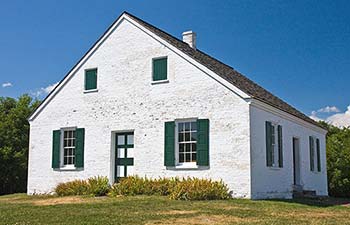
Dunker Church
The Battle of Antietam, fought September 17, 1862, was one of the bloodiest
battles in the history of this nation. Yet, one of the most noted landmarks
on this great field of combat is a house of worship associated with
peace and love. Indeed, the Dunker Church ranks as perhaps one of the
most famous churches in American military history.
This historic structure began as a humble country house of worship
constructed by local Dunker farmers in 1852.
It was Mr. Samuel Mumma, owner of the nearby farm that bears his name,
that donated land in 1851 for the Dunkers to build
their church. He also allowed members of the congregation to be buried
in the Mumma family cemetery located a few hundred yards to the east of
the church. In 1853 the church was dedicated and during its early history
the congregation consisted of about half a dozen farm families from the
local area.
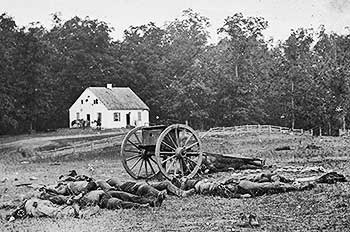
During The Battle
On the eve of the Battle of Antietam, the member of the Dunker congregation
as well as their neighbors in the surrounding community received a portent
of things to come. That Sunday, September 14, 1862, the sound of cannons
booming at the Battle of South Mountain seven miles to the east was
plainly heard as the Dunkers attended church. By September 16 Confederate
infantry and artillery was being positioned around the church in anticipation
of the battle that was fought the next day.
During the battle of Antietam the church was the focal point of a number
of Union attacks against the Confederate left flank. Most after action
reports by commanders of both sides, including Union General Hooker
and Confederate Stonewall Jackson, make references to the church.
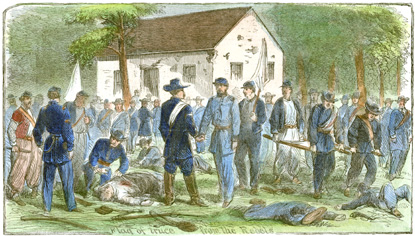 |
|
Truce at the Dunker Church -
Alfred Waud
|
At battles end the Confederates used the church as a temporary medical
aid station. A sketch by well known Civil War artist Alfred Waud depicts
a truce between the opposing sides being held in front of the church
on September 18, in order to exchange wounded and bury the dead. At
least one account states that after the battle the Union Army used the
Dunker Church as an embalming
station. One tradition persists that Lincoln may have visited the
site during his visit to the Army of the Potomac in October 1862.
As for the old church, it was heavily battle scarred with hundreds
of marks from bullets in its white washed walls. Likewise artillery
had rendered serious damage to the roof and walls.. By 1864 the Church
was repaired, rededicated and regular services were held there until
the turn of the century.
After the War
By the end of the 19th century membership had dwindled. The congregation
built a new church in the town of Sharpsburg. Veterans that returned
often had their picture taken in front of the church. Over the years
souvenir hunters took bricks from the walls. A lack of adequate repair
and maintenance left weakened structure and in 1921 a violent wind and
hailstorm swept through the area flattening the church. With no plans
to rebuild the church, the Board of Trustees voted to relinquish all
claims to the property and have it revert back to the Mumma family.
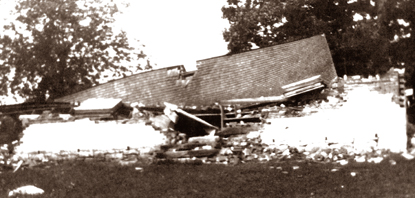 |
|
The destroyed Dunker Church -
NPS photo
|
In 1924 the land and church ruins were put up for sale and purchased
by Sharpsburg resident Elmer G. Boyer. He salvaged most of the undamaged
material of the building and in turn sold the property. The new property
owner built a home on the foundation of the old church and in the 1930's
operated a gas station and souvenir shop on the site. This structure
was removed in 1951 when the property was purchased by the Washington County
Historical Society. They in turn donated the site, now just a foundation,
to the National Park Service. Because the Dunker church was a prominent
battlefield landmark, its reconstruction was a long term goal of the National
Park Service. In 1960 The State of Maryland provided the NPS with $35,000
to reconstruct the church. The present Dunker
Church, standing on the original site was completed
late in 1961. Many of the original salvaged materials were purchased from
Mr. Boyer and are now integral parts of the reconstructed church. These
include 3,000 bricks, door and window frames, some flooring, and a number
of benches.
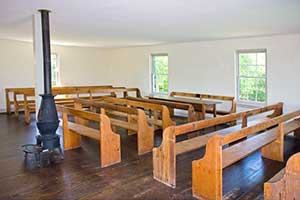
The Dunker Church Today
A visit to the Dunker Church today is like a step back into time. Note
the simplicity of the church with its plain windows, crude wooden
benches on which you may have sat for hours during the services in bygone
years; and the simple table at the front where the elders of the church
would have read from the old Bible. Take a seat inside and contemplate
the sacrifice of the people of 1862.
(Information courtesy of the National Park Service)
Copyright © 2005-2006 Calvin & Rosanna Hamilton. All rights reserved.




